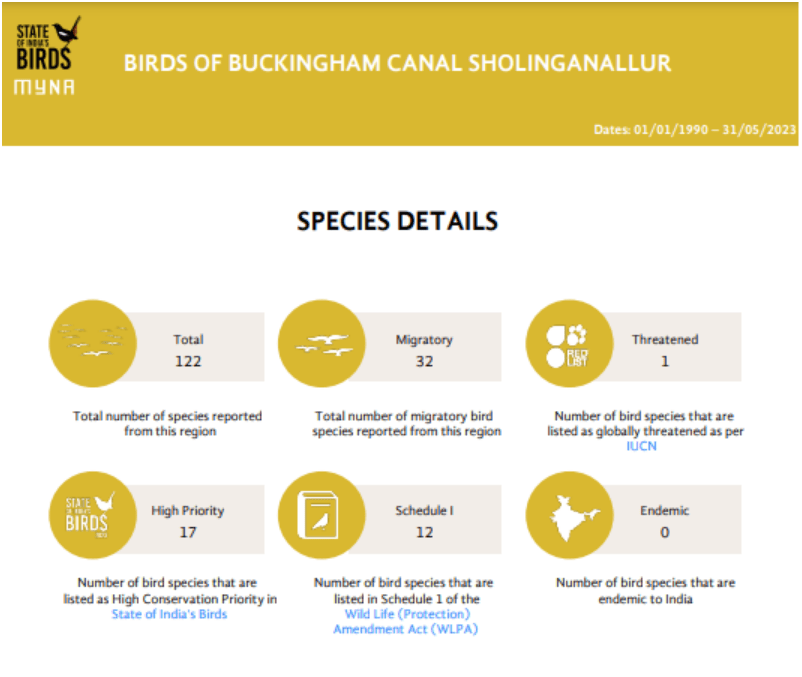Illegal dumping of garbage, cement, construction debris, and other waste has become rampant all over Chennai, despite existing regulations. Many wetlands and water bodies in and around the city are shrinking due to indiscriminate disposal of waste materials, which harms the local flora and fauna. Blocking canals and wetlands with debris can also result in flooding of nearby areas.
I first observed cement residue being dumped into the Buckingham Canal on June 11th this year, and this continued till June 15th. The dumping appears to be originating from various infrastructure development activities, particularly from the construction of apartments on TNHB Main Road.
Subsequently, while travelling along the southern areas of the canal — from Akkarai signal to Sholinganallur via Kalaignar Karunanithi Salai, and then turning left towards K School — I noticed cement residue dumped on the banks of the Buckingham Canal and even in the nearby marshland. This dumping is observed consistently throughout the day.
Cement dumping can cause floods

In Chennai, the Buckingham Canal serves as a crucial drainage system for floodwaters, especially in South Chennai, which has experienced significant growth due to the IT boom. The canal is the primary outlet for floodwaters in this region. During monsoons, rainwater from Velachery to Siruseri flows into various reservoirs and eventually enters the floodplain of the Pallikaranai marsh. From there, it drains through Okkiyam Maduvu and enters the Buckingham Canal near Thoraipakkam.
Read more: Construction debris clogging beach near Besant Nagar: When will the violations stop?
The floodwater channels into the Bay of Bengal via Muttukadu, near the backwaters of Kovalam Beach, through the Buckingham Canal. To safeguard South Chennai from flooding and ensure efficient water drainage, monitoring and protecting the canal from Okkiyam Madavu to Muttukadu is crucial, and the authorities must prevent any dumping or depletion.
Moreover, the flow of rainwater through canals revitalises various lush ecosystems within the city. However, over time, these canals have suffered from depletion due to the disposal of non-recyclable plastic waste, construction debris, cement residue, and the mixing of sewage water at multiple points. In the case of Buckingham Canal, we have observed large amounts of cement residue clogging its outer embankments and this poses a threat of inundation during heavy rains.
Birds of Pallikaranai affected by cement dumping

The stretch near the Buckingham Canal, where cement residue has been dumped is home to various flora and fauna. The affected area is close to the Pallikaranai marshland (Sholinganallur block) and home to many local and migratory birds.
About 122 species of birds have been recorded in this region — Glossy Ibis, Black-headed Ibis, Painted Stork, Pelican, Bronze-winged Jacana, Pheasant-tailed Jacana, Open-billed Stork, Common Snipe, Painted Snipe, Little, Intermediate and Great Egrets, Little, Indian and Great Cormorants, darter, Spot-billed duck, Black Drongo, weaver, Silverbill, sparrow, Blue-tailed Bee-eater, Green-tailed Bee-eater, Red-wattled lapwing, Yellow-wattled lapwing, Gray-headed lapwing, White-breasted Waterhen, Moorhen, Coot, Gray-headed swamphens, Little grebes, Spotted eagle, Shikras, Black kites and many more.
The cement residue and other pollutants can harm the birds and cause irreversible damage to the ecology of the region. The dumping also affects human health and it will be hard to reverse the impact in the future.
Read more: Rampant garbage burning reveals gaps in waste management in Pune’s Pimpri-Chinchwad
Monitoring and regulation necessary to protect canals
Continuous monitoring of Buckingham Canal is the need of the hour. A strong alliance of different TN government departments including the Greater Chennai Corporation, Public Works Department, Forest Department, the Natural Disaster Management Authority and the Chennai Metropolitan Development Authority will ensure better vigilance and help reduce the illegal disposal of waste in canals and marshlands, avoid their deterioration and help protect these important ecological sites.
With the boom in construction, there is also the likelihood of ecological sites being encroached upon by unauthorised high-rises and road expansion projects. Such constructions have led to the dumping of cement residue or building waste into marshes.
Once marshes get depleted, they are often converted to residential plots or commercial spaces. This is a constant cycle of ‘development’ in metropolitan cities these days. The appropriate authorities must act immediately and take necessary action on this issue and stop further dumping of cement or other residues before the same depletes the whole ecosystem.